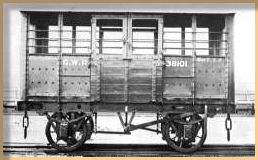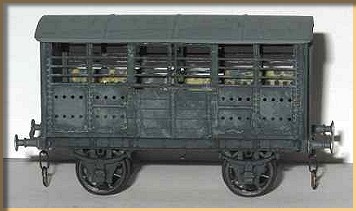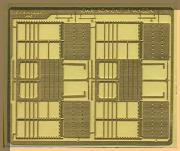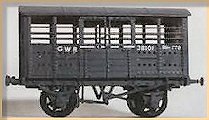| Section Page | Previous Page | Next Page |
Shirescenes 4mm Iron Cattle wagonby Graeme Pettit
Model constructors will need to be aware of the changes which took place over the years, and incorporate these for any given point in time, and also note that the kit is not accurate, being designed specifically to fit the Ratio Iron Mink van. According to the Historical Model Railway Society, the van was outshopped with 3' plain 8-spoke wheels, grease axleboxes, and braking on one side only, of the double block type shown in the photo above from the BR archives. Note too, the use of 3-link couplings. It was condemned in 1935, and probably broken up. Modifications for modellers to note were as follows:
The nice little etch from ShireScenes is intended to be used in conjuction with an Ratio Iron Mink plastic kit. The instructions are very basic, comprising a drawing and a couple of notes, but, if thought about carefully before building, the kits combine to make a very attractive little vehicle.
Everything folds up cleanly, and can be glued in place – my preference being to use superglue. I do recommend using a cocktail stick or other similar tool/implement to apply the glue, as some of the parts are very fine indeed, and overspill is likely if care is not taken. The second V hanger in the kit should only be used if adding a second set of brake shoes, along with the associated brake lever that was fitted for the 1928-35 period. This will also require the appropriate later livery.
Against it, is the fiddly etching and delicate work to do a good job, but what makes it harder to swallow, is that it can work out quite pricey to complete to a high standard, and it is, after all, dimensionally inaccurate. If you price up the Ratio kit at around £4.00, then add £4.75 for the etch, another £1.50 for wheels, then the couplings of your choice, and other items such as some cast buffers, the cost rises to that approaching a full brass kit. Conclusion
ShireScenes are to be applauded for doing such a good job, of what would be a very difficult item to scratchbuild. However, I do feel that it should be offered as a complete kit, with better instructions, and at a (higher) price more reflective of the value of the improved contents, (such as wheels, bearings, buffers, Ratio bits, extra brake levers and blocks), and should be supplied with a small set of pressfix lettering suitable to the unique nature of the wagon. |
| Section Page | Previous Page | Next Page |
 The van represented by this etch from Shirescenes was unique, there being only one ever built. It was developed from the Iron Mink vans of the 1880s, a design adopted and adapted by many other railways over the years. Outshopped in 1888, the van was an inch over 16' long, and was numbered 38101, to carry 8 Tons, with a tare weight of 7.7.0 until modified later in its life.
The van represented by this etch from Shirescenes was unique, there being only one ever built. It was developed from the Iron Mink vans of the 1880s, a design adopted and adapted by many other railways over the years. Outshopped in 1888, the van was an inch over 16' long, and was numbered 38101, to carry 8 Tons, with a tare weight of 7.7.0 until modified later in its life. Care is needed when cutting out the etch, and, whilst the instructions recommend using a sharp blade to alter the side mouldings in the Ratio kit, a small sharp saw is preferable to cut up the parts cleanly – just such a saw is made by Exacto for modelling purposes – very stiff, and safe to use, even in small hands under parental supervision.
Care is needed when cutting out the etch, and, whilst the instructions recommend using a sharp blade to alter the side mouldings in the Ratio kit, a small sharp saw is preferable to cut up the parts cleanly – just such a saw is made by Exacto for modelling purposes – very stiff, and safe to use, even in small hands under parental supervision. The kit, being based on a readily available and well designed plastic item, makes for fairly easy building. It is a unique protototype, and a very attractive one too in an ugly sort of way. It would not look out of place on any layout pre-1935 in period, even as a visitor.
The kit, being based on a readily available and well designed plastic item, makes for fairly easy building. It is a unique protototype, and a very attractive one too in an ugly sort of way. It would not look out of place on any layout pre-1935 in period, even as a visitor. This is another kit highly suitable for those modellers wishing to find a stepping stone from working in plastic or whitemetal to brass, but only if you like the idea of running a fairly unique vehicle on your layout, and an early layout to boot.
This is another kit highly suitable for those modellers wishing to find a stepping stone from working in plastic or whitemetal to brass, but only if you like the idea of running a fairly unique vehicle on your layout, and an early layout to boot.